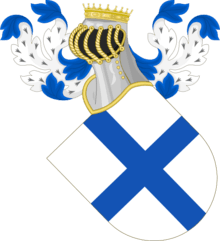Matilda II, Countess of Boulogne
| Matilda II of Boulogne | |
|---|---|
.png) | |
| Queen consort of Portugal and the Algarves | |
| Tenure | 4 January 1248 – 1253 |
| Countess of Boulogne | |
| Tenure | 1216–1260 |
| Predecessor | Ida and Renaud |
| Successor | Adelaide |
| Born | 1202 |
| Died | January 1259 (aged 56–57) |
| Spouse |
Philippe Hurepel, Count of Clermont-en-Beauvais Afonso III of Portugal |
| Issue |
Joan, Countess of Nevers, Lady de Châtillon-Montjay Alberic, Count of Clermont |
| House | House of Dammartin |
| Father | Renaud, Count of Dammartin |
| Mother | Ida, Countess of Boulogne |
Mahaut or Matilda II of Boulogne (also known as Mathilde, Maud de Dammartin; 1202 - January 1259) was Countess of Boulogne in her own right and Queen of Portugal by marriage to King Afonso III from 1248 until their divorce in 1253. She was the daughter of Ida, Countess of Boulogne and her husband and co-ruler Renaud, Count of Dammartin.[1] She succeeded her mother as Countess of Boulogne in 1216. She was the great-granddaughter of King Stephen of England.
First marriage
In 1223, Matilda married her first husband, Philippe Hurepel, Count of Clermont-en-Beauvais, a younger, arguably illegitimate son of King Philip II of France.[1] By marriage to her, Philippe became her co-ruler of Boulogne, Mortain, Aumale and Dammartin-en-Goële.[1] Count Philippe revolted against his widowed sister-in-law, Blanche of Castile, when his half-brother King Louis VIII died in 1226.[2]
Second marriage
Count Philippe died in 1234,[3] and Matilda reigned independently for three years. To give the county a male head, she married again in 1238 to Infante Afonso, second in line to the Portuguese throne, younger brother of King Sancho II of Portugal. He became King Afonso III of Portugal on 4 January 1248. At that time he renounced Boulogne.
In 1258, Matilda charged Afonso with bigamy, following his marriage to Beatrice of Castile.[4] Pope Alexander in response, imposed interdict upon any place the couple stayed.[4] At the time of Matilda's death, Afonso and Beatriz were still together, despite the Pope's protests.[4]
Later life
She had a son and a daughter with Count Philippe, but no surviving issue with Afonso. Matilda's then apparent barrenness was the true reason for their divorce. According to reports, Queen Matilda remained in Boulogne and was not allowed to follow her husband to Portugal.
Her son reportedly renounced his rights and went to England, for unknown reasons. Apparently he survived his mother the Countess, but presumably did not leave issue. Matilda's daughter, having married a lord de Châtillon-Montjay, predeceased her, and presumably left no surviving issue.
Aftermath
After Matilda II, the county of Boulogne passed to Adelaide of Brabant, Matilda's cousin, daughter of another Matilda of Boulogne (Matilda II's aunt, wife of Henry I, Duke of Brabant).
The then-widow Adelaide's husband had been William X, Count of Auvergne. Their son Robert of Auvergne succeeded also his mother in Boulogne and already in her lifetime acted as co-ruler. Their heirs continued to rule Auvergne and Boulogne together. The ultimate heiress was Catherine de' Medici, Queen of France, but a couple of decades before her, the then Count of Auvergne, her great-grandfather, had sold Boulogne to the French throne, keeping just Auvergne.
Ancestry
| Ancestors of Matilda II, Countess of Boulogne | ||||||||||||||||||||||||||||||||||||||||||||||||||||||||||||||||||||||||||||||||||||||||||||||||||||||||||||||||||||||||||||||||||||||||||||||||||||||||||||||||||||||||||||||||||||||||||||||||||||||||||||||||||||||||||||||||||||||||||||||||||||||||||||||||||||||||||||||||||||||||||||||||||||||||||||||||||||||||||||||||||||||||||||||||||||||||||||||||||||||||||||||||||||||||||||||||||||||||
|---|---|---|---|---|---|---|---|---|---|---|---|---|---|---|---|---|---|---|---|---|---|---|---|---|---|---|---|---|---|---|---|---|---|---|---|---|---|---|---|---|---|---|---|---|---|---|---|---|---|---|---|---|---|---|---|---|---|---|---|---|---|---|---|---|---|---|---|---|---|---|---|---|---|---|---|---|---|---|---|---|---|---|---|---|---|---|---|---|---|---|---|---|---|---|---|---|---|---|---|---|---|---|---|---|---|---|---|---|---|---|---|---|---|---|---|---|---|---|---|---|---|---|---|---|---|---|---|---|---|---|---|---|---|---|---|---|---|---|---|---|---|---|---|---|---|---|---|---|---|---|---|---|---|---|---|---|---|---|---|---|---|---|---|---|---|---|---|---|---|---|---|---|---|---|---|---|---|---|---|---|---|---|---|---|---|---|---|---|---|---|---|---|---|---|---|---|---|---|---|---|---|---|---|---|---|---|---|---|---|---|---|---|---|---|---|---|---|---|---|---|---|---|---|---|---|---|---|---|---|---|---|---|---|---|---|---|---|---|---|---|---|---|---|---|---|---|---|---|---|---|---|---|---|---|---|---|---|---|---|---|---|---|---|---|---|---|---|---|---|---|---|---|---|---|---|---|---|---|---|---|---|---|---|---|---|---|---|---|---|---|---|---|---|---|---|---|---|---|---|---|---|---|---|---|---|---|---|---|---|---|---|---|---|---|---|---|---|---|---|---|---|---|---|---|---|---|---|---|---|---|---|---|---|---|---|---|---|---|---|---|---|---|---|---|---|---|---|---|---|---|---|---|---|---|---|---|---|---|---|---|---|---|---|---|---|---|---|---|---|---|---|---|---|---|---|---|---|---|---|---|---|---|---|---|---|---|---|---|---|---|---|---|
| ||||||||||||||||||||||||||||||||||||||||||||||||||||||||||||||||||||||||||||||||||||||||||||||||||||||||||||||||||||||||||||||||||||||||||||||||||||||||||||||||||||||||||||||||||||||||||||||||||||||||||||||||||||||||||||||||||||||||||||||||||||||||||||||||||||||||||||||||||||||||||||||||||||||||||||||||||||||||||||||||||||||||||||||||||||||||||||||||||||||||||||||||||||||||||||||||||||||||
References
- 1 2 3 Charles T. Wood, The French Apanages and the Capetian Monarchy: 1224-1328, (Harvard University Press, 1966), 9.
- ↑ Malcolm Barber, The Two Cities: Medieval Europe 1050–1320, (Routledge, 1992), 266.
- ↑ Charles T. Wood, The French Apanages and the Capetian Monarchy: 1224-1328, 37.
- 1 2 3 H.V. Livermore, A History of Portugal, (Cambridge University Press, 1947), 136.
| Wikimedia Commons has media related to Matilda of Boulogne (1260). |
| Regnal titles | ||
|---|---|---|
| Preceded by Ida and Renaud |
Countess of Boulogne 1216 – c. 1260 with Philip I (1223-35) Alphonse (1238-48) |
Succeeded by Adelaide |
| Portuguese royalty | ||
| Preceded by Mécia Lopes de Haro |
Queen consort of Portugal 4 January 1248 – 1253 |
Succeeded by Beatrice of Castile |
